Are you headed to Akureyri to see the northern lights? Fantastic choice! Akureyri and northern Iceland is one of the best places in the world to see the northern lights. In this article we will go over everything there is to know about seeing the northern lights in Akureyri so you have the best chance possible to spot the aurora on your trip.
Iceland is a sparsely populated country with magnificent mountains, glacial beaches, and epic volcanic activity. Every year approximately 2 million people visit Iceland for tourism, many coming in fall or winter to see the northern lights.
Nearly all these visitors, however, stay in or around Reykjavik and few venture to the rugged north side of the island. You’re not like most people though, are you? You’re ready for an adventure. So let’s go northern lights chasing in Akureyri, Iceland!
Note: this article contains affiliate links, which means that should you purchase something or get a quote through them I may make a small commission at no additional cost to you. This helps keep the site running with up to date information. I do not represent World Nomads, Booking.com, GetYourGuide, or Rentalcars.com. This is information only and not a recommendation to buy the product mentioned in this article.
Akureyri – What You Need to Know
Where is Akureyri?
Akureyri is on the northern coast of Iceland at the end of a long fjord. It’s the most populated city in Iceland outside of the southwest corner (where Reykjavik lies). But take that with a grain of salt, as barely 19,000 people call Akureyri home.
It’s the de facto capital of the Northeastern Region of Iceland. With a population of about 30,000 people, the Northeastern Region of Iceland is a great place to avoid light pollution and other people.
How to get to Akureyri
The best way to get to Akureyri is to drive from Keflavik Airport (Iceland’s main airport that has direct flights to many cities in Europe and North America). It’s a solid 5 hour drive, and that’s on a good day with no hazardous road conditions, which is rare in Icelandic winters. Allow 6-7 hours to make the drive, not including time for stops.
If you don’t have a car, there is daily bus service on the Route 57 bus that runs between Reykjavik and Akureyri. It will cost you about $60-80 USD. However, I always recommend having your own car in Iceland.
Alternatively, should you wish to avoid the highway, there are multiple daily flights between Reykjavik and Akureyri. You could easily take the short flight and rent a car from Akureyri.
Just be aware that the flights depart from Reykjavik City Airport and not Keflavik International Airport. So should you want to fly to Akureyri you’ll have to transfer between airports, which are about 45 minutes apart by car or bus.
How to get around Akureyri and Northeastern Iceland
A rental vehicle is essential in this part of Iceland. You just won’t get the same experience without one. There are numerous tour companies that will pick you up from a hotel in Akureyri and drive you around to the main sites and at night for the northern lights. But you’ll miss out on the freedom to choose your own route without a car. While Icelandic roads can be treacherous in winter, 4WD rentals are common and tires are equipped to drive on snowy and icy roads.
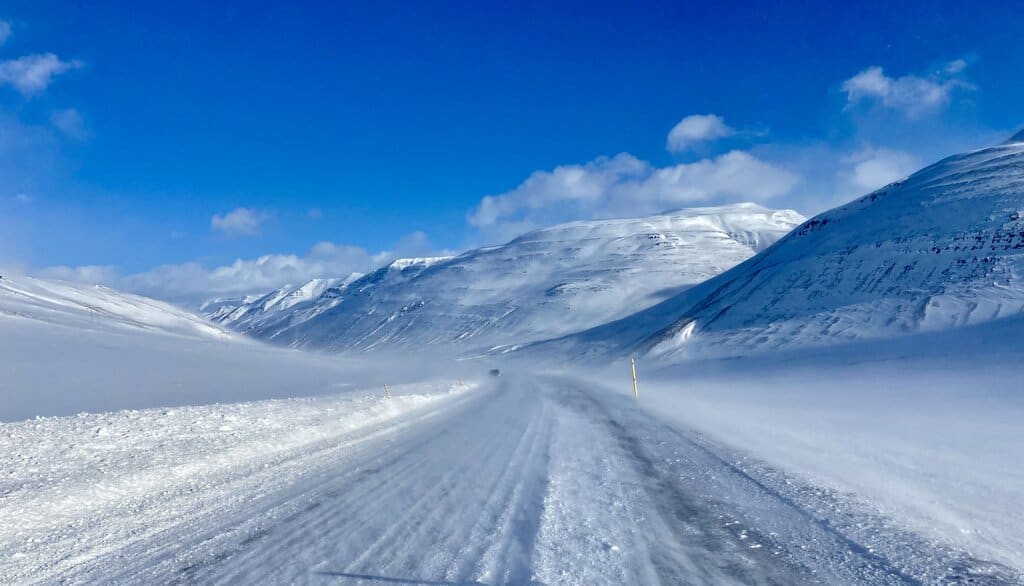
You can browse and book rental cars from the Reykjavik Airport using the search bar below.
Driving in Iceland is thrilling, but it can also be dangerous if you’re not prepared and not following the weather. You don’t want to be out driving in a storm. You also will want to check the road conditions frequently, as many of the smaller roads don’t get paved as quickly as the Ring Road (the main highway that circles the island) and are often closed. Be sure to check the official Iceland road condition website each day.
Lastly, if you’ve never drive in Europe before, be sure to check out my guide to driving in Europe before your trip.
Weather and when to visit
While the aurora borealis is active year-round, you can only see it when the sky is black. Iceland is so far north that in late spring and summer the sky never actually gets dark. The northern lights can be seen between early September and mid April.
It’s said that the most active aurora comes around the fall and spring equinoxes. If you can plan your trip around then, you’ll get darkness in the sky and warmer weather outside to enjoy outdoor activities in the daylight. The darkness of the night lasts much longer in December and January, meaning you have more chances to see the lights. But those months receive the most rain and snow, so clear skies might be tough to come by.
The weather in Iceland can be downright brutal. Especially in winter, when it snows a lot and roads can become icy. While it never actually gets that cold – usually just above freezing as daily winter highs and lows about 3 to 4 degrees below zero (24-25 F) – the wind can be punishing and make it feel far colder than it actually is.
January and February get the most snow and are the coldest. Northern Iceland gets more snow than southern Iceland, but in general has clearer skies. Though it can snow any time of the year, your best bet for getting some decent weather and enough darkness in the sky is October.
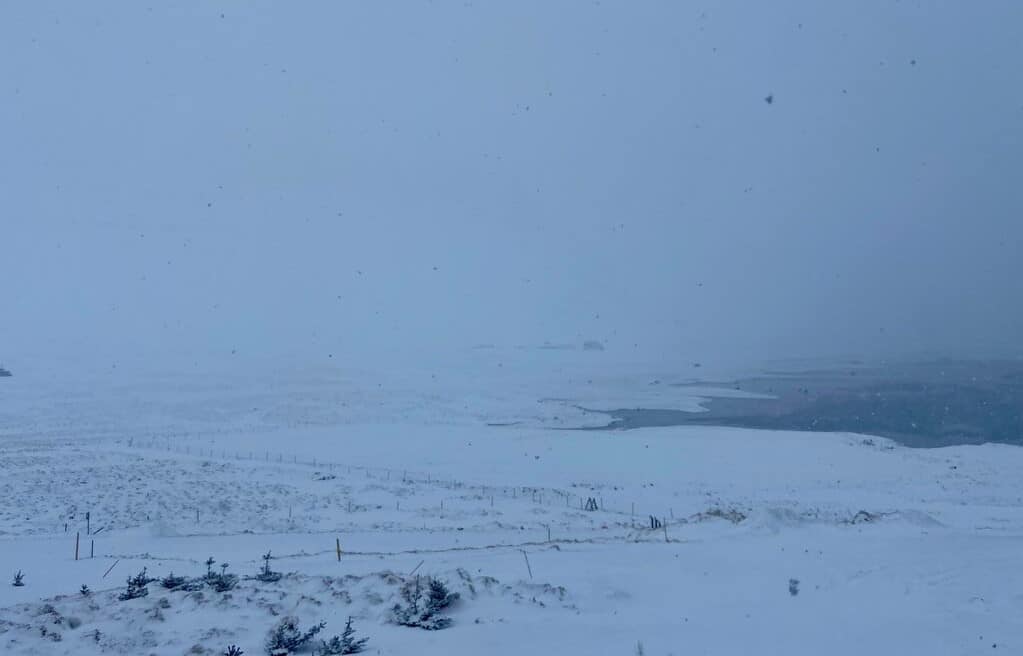
If all this sounds like a bit too much for you, perhaps you should consider visiting Iceland in the summer. Our trip to Aukreyri was in early March and while we were blessed with multiple clear nights and many northern lights sightings, it was still very cold and windy. We have also been to Iceland in October and December and can say that October would be our choice if we went again.
Where to stay in Akureyri
Ideally you want to stay a bit outside the city. While it’s a little city, it’s still a city and has some light pollution. There are tons of cabins, apartments, and other rentals on the outskirts of town and the general Northeastern Iceland region that are perfect for northern lights viewing.
We stayed at Sunnuhlid Houses about 15 minutes outside of town and can recommend it. The owner, Karl, built the cabins himself and is extremely helpful when needed. Otherwise, check out the other listings on booking.com to find a great place to stay in or outside of Akureyri.
How long to stay
When catching a glimpse of the northern lights is your goal, you’ll need time. Clear skies are not guaranteed but they’re essential for seeing the lights. You’ll often hear of people who travel to Iceland or the Arctic for an entire week and don’t get a single clear night.
To make the best of the opportunity, you’ll want to spend a bare minimum of 4 nights in Iceland. If you can spend a week, that would be preferable. And even then you still have to hope the weather will cooperate.
You don’t necessarily have to stay in Akureyri the entire time on your northern lights adventure. But northern Iceland is often more clear than the southern half of the island so your chances of seeing the lights are a bit better.
That being said, there is not really an entire week’s worth of daytime things to do in Akureyri. So if you’re staying longer than four days, it’s best to move on to elsewhere along the Ring Road.
Language
Icelandic as a language is basically impossible. Good thing literally everyone in Iceland speaks perfect English. Your biggest challenge will be pronouncing the street names.
Money
Iceland has its own currency, the Icelandic Krona. You likely will not need any cash on your trip, but it’s good to have a little just in case. There have been times when our credit cards did not work at supermarkets and we had to rely on cash.
Overall, Iceland is not a cheap country. For Europeans it is very expensive, somewhere in between the UK and Norway, more towards Norway prices. That being said, if you’re an American from a big city like NY or LA you really won’t notice the prices considering how expensive everything is in the US these days.
Cabin rentals are remarkably affordable in the winter. You can rent a beautiful two-bedroom log cabin for under 150 euros per night. Summer is a whole other story. More people visit in the summer and accommodation prices are considerably more.
Restaurant prices outside of Reykjavik are on par with prices in most major American cities, keeping in mind that tax and service charge are already included in the menu prices. Excursions are expensive, but if you have your own vehicle you don’t even need to consider any of these. So yes, it’s possible to visit Iceland on a budget but you have to be smart about it.
Food and Restaurants
There are not a whole lot of places to eat in Akureyri. And surprisingly, there are limited seafood restaurants. The locals recommend RUB23, a sushi restaurant as the place to be. There is also a famous fish and chips stand that is supposed to be amazing, but unfortunately it’s not open in the winter or on the weekends.
If a cold brew is what you’re looking for, look no further than the Einstok Brewers Lounge downtown. Einstok is the most well known micro brewery in Iceland and it’s in Akureyri. You can actually get Einstok in the US now at Total Wines & More. But it tastes better sitting in the warm brewers lounge watching a football match. Make sure to get there for happy hour, where beers are only about $6 USD.
Travel insurance
For your trip to Iceland you’ll want to have a quality travel insurance policy. We use World Nomads when we travel internationally. World Nomads provides coverage to travelers in over 100 countries. You can find a great policy on World Nomads by using the link below.
A Quick Intro to Akureyri
Originally founded in the 9th century, Akureyri is now Iceland’s most populated city outside of the Reykjavik region. It’s the so-called capital of northern Iceland and about 19,000 people call it home. At about 65 degrees north, it’s just south of the Arctic Circle and has constant daylight in the summer. Flanked by impressive mountains on each side and lying at the end of a fjord, the city sits in a truly beautiful location of northern Iceland.
That being said, the city itself is not exactly what you think of when you think of a charming European city. It’s more utilitarian and you’ll be hard pressed to find a resident that would describe the city itself as beautiful. But one look into the mountains will make it clear why the locals call it home. There is a small downtown in Akureyri with numerous restaurants and bars. It’s hilly and parking is cheap and free in the evenings.
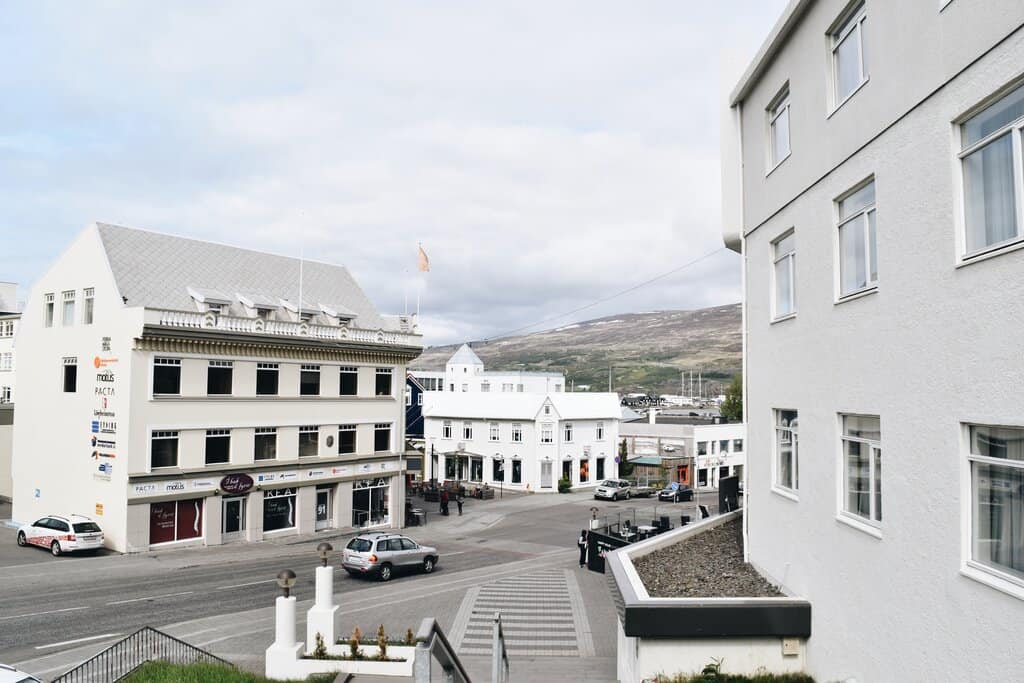
Things to see and do in Akureyri
In the daylight hours you’ll have the chance to explore the city in more detail. This won’t take long as there are not too many attractions in the city itself outside of whale-watching season. Here’s a quick rundown of some stops to make on a short walk around Akureyri:
- Akureyrarkirkja: This eccentric Lutheran church sits atop a hill in the city center and is arguably the city’s main landmark and top attraction. It’s possible to go inside the church and also to join a sermon if you’d like.
- Hof Cultural and Conference Center: The Hof is where you can go to catch a live show or see some live theater. It’s also a magnificent and modern new building with a small café. Good for fans of modern architecture if you’re not going for a show.
- Akureyri Botanical Garden: The city’s botanical garden is closed from October through May (for obvious reasons). But if you’re visiting in late September you can still see the garden before winter takes over.
- Akureyri Art Museum: If you’re curious to see some Iceland art, then the Akureyri Art Museum might be worth a stop.
- Akureyri Museum: If you want to learn a little about the history of Akureyri and the surrounding region head to the Akureyri Museum on the south side of town.
Groceries and essentials
If you’re staying at a cabin or somewhere with a kitchen, you’re going to be doing a little cooking yourself. Luckily Akureyri has a number of supermarkets. The main supermarkets are Bonus and Netto.
Both supermarket chains are all over Iceland and have large stores in Akureyri with a lot of options. Just remember the tap water in Iceland is some of the best in the world so don’t waste your money on fancy bottled water.
Akureyri also has a big mall with international stores like H&M and the Body Shop. If you forgot anything, you’ll be able to find it at the mall. Outside of the city you’re unlikely to find much other than small supermarkets. So if you need anything, get it in Akureyri before setting out for the day.
How to See the Northern Lights in Akureyri
Seeing the northern lights is not really something you need any particular set of skills for. It’s really just a matter of preparation, luck and timing. As I’ve said before, the two most vital ingredients for seeing the northern lights are clear, dark skies and solar winds. Luckily, in Akureyri, the solar winds are strong just about every night and you have a chance to see them any time the sky is clear and dark. And with how small Akureyri is, you can see them from just about anywhere.
The Kp Index
Before attempting to view the northern lights it’s important to get familiar with the Kp index. The Kp index measures the disturbance of the earth’s magnetic field caused by solar winds. The faster the solar winds, the more disturbance and the greater change there is to see the aurora borealis.
It’s important to note that solar wind and the wind you feel when standing outside on a cold Icelandic night are not the same thing at all. Kp forecasts are available online and through numerous smartphone apps and work on a 1 to 9 ranking system.
Kp Index 0-1
Indicates that the solar winds are low. It’s possible to see the northern lights but unlikely. If you see a Kp of 0 or 1, it’s best to use that time to catch up on sleep.
Kp Index 2
Kp 2 is – at least in my experience – the baseline for northern Iceland. Pretty much every night has at least a Kp 2 forecast. This means that if the skies are clear, you are likely to see the lights. They may not dance across the sky in bright colors, but they will be visible to the naked eye. If the forecast is for Kp 2, it’s worth staying up for.
Kp Index 3-4
This means that the solar winds are moving faster and there will be more aurora activity in the sky. If the skies are clear do not waste any time and get out there!
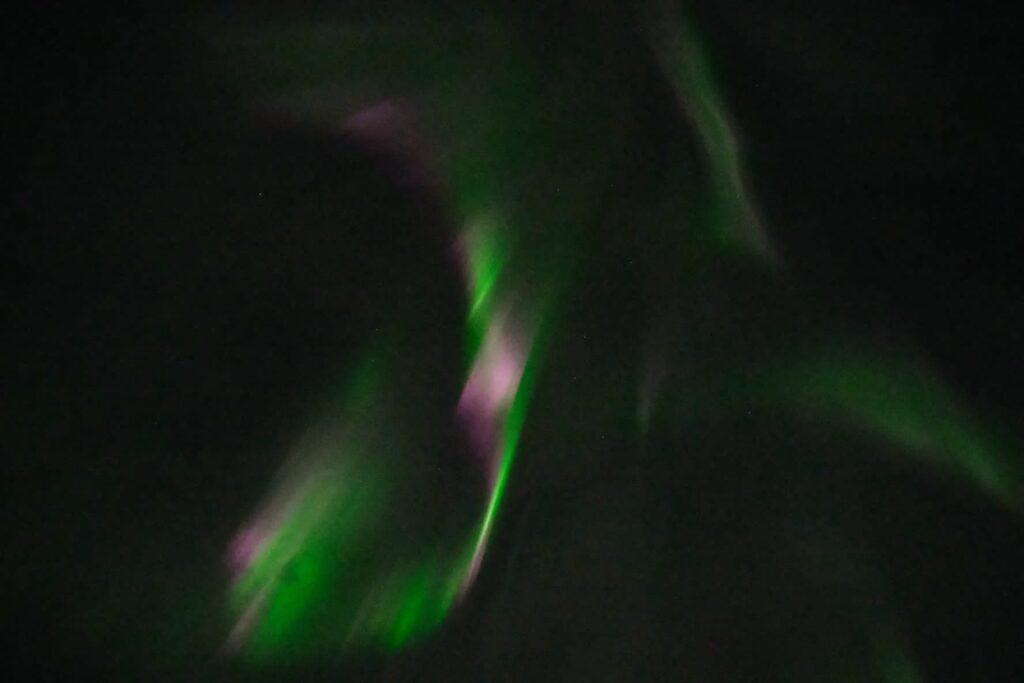
Kp Index 4-5
Indicates that a minor solar storm is underway. Don’t be confused by the word “storm.” A solar storm is a good thing! You’ll likely see more than the typical green light. Bright red and purple lights are definite possibilities and the lights are likely to dance across the sky in all sorts of patterns. If you see a Kp index this high in your forecast, consider yourself lucky and pray for clear skies.
Kp Index 7-0
Kp 7 to Kp 9 means that the solar storm is intense. People living in the UK and southern Canada are probably gonna see the northern lights. Up in Akureyri you’ll get an insane light show should the weather hold out for you. Kp forecasts this high are rare though. It happens a few times every year, but don’t expect to get this lucky.
Drive yourself around
The best way to see the northern lights is to have your own vehicle. This gives you the freedom to drive towards clearer or darker skies. You can also stay warm by running the car and keeping the heat on.
In order to clearly see and photograph the northern lights you’ll need to be outside. And even if Iceland isn’t as cold as a winter night in North Dakota, it can still get pretty damn cold with the howling winds. Having a car to warm up in is essential.
Places to stop to see the northern lights in Akureyri
Perhaps the trickiest part of catching a good northern lights show is finding somewhere to stop the car and pull over when you’re out driving around. If you’re in the comfort of your cabin or vacation rental, then great. But you won’t always be lucky enough for that and you’ll have to get out on the road at some point.
Many blogs will try to tell you the “best places” to see the northern lights. But the truth is no one controls where they appear. The best place is wherever you happen to see them.
The roads in northern Iceland are quite narrow and don’t have break down lanes. Most roads don’t have anywhere to pull over, and you won’t want to stop in the middle of the road unless you have a death wish. In the map below, I’ve assembled some side of the road parking areas and small dirt roads that are safe to stop at and take out your camera.
What to wear
While you can sometimes see the lights from the comfort of your heated car, you’re going to be outside a lot on a night of aurora hunting. As you can imagine, you will need to dress for the occasion. Wear multiple layers and make sure all body parts are covered.
You will need thick winter gloves, but you will also need thinner gloves that will allow you to comfortably operate your camera. The thin gloves won’t do a whole lot more than keep you from getting frostbite, and your fingers will still be freezing, but they are better than nothing. We use hand and feet warmers that we put in our gloves and socks to keep our extremities warm.
Northern lights photography
While smartphone cameras have come a long way and will clearly pick up northern lights if you keep your hand still, if you’re serious about the northern lights you’ll need a good digital camera to take proper photos. There are many blogs that go over the basics of northern lights photography, but in general you’ll have to control the aperture and shutter speed for amazing northern lights photos.
A wide-angle lens (24mm or less) with a fast aperture (2.8 or faster) is needed. Set the focus to infinity, the aperture to the lowest possible level, 2.8 or so. Start by setting ISO to 800 and the shutter speed to 20 seconds and from there, based on intensity of the aurora, try different combinations of ISO and exposure to find the ideal combination to capture them bright and sharp.
Shoot the photos in RAW mode so the post editing of the photos becomes easier later on and you won’t lose the quality of photos. Be patient and be prepared to do trial and error, as there is quite a learning curve involved.
For northern lights photography, a tripod is essential. You’ll never be able to hold the camera still enough on your own. The camera will be set to a shutter speed of about 5-20 seconds. Any movement in that time will make the photo blurry. You’ll also want a head torch to shine light on your camera while you’re adjusting the settings so you can use both hands.
PRO TIP: Want sweet photos of yourself in front of the northern lights? Have someone shine a flashlight on you during the photo. If you don’t do this you will just be a dark blob in the photo as your camera will focus on the lights in the sky and ignore you.
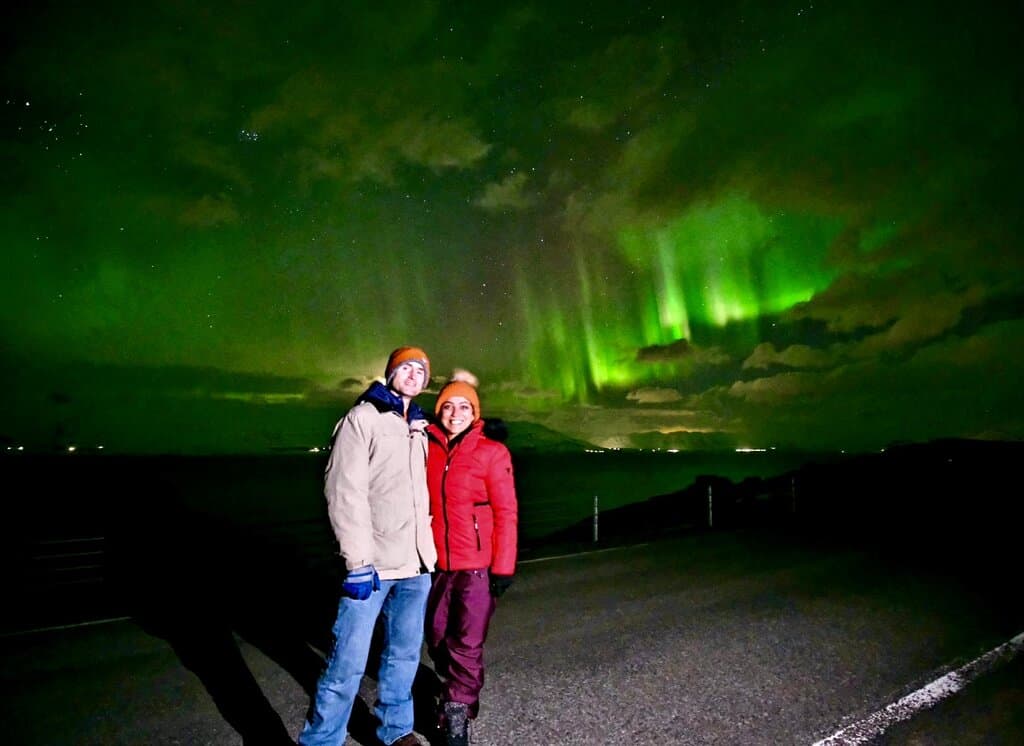
Organized excursions
If driving around on Icelandic roads in the night isn’t your cup of tea, or you just want someone else to drive you around, then an organized excursion might be for you. You’ll also get the benefit of going with a local guide that is knowledgeable about the northern lights and seeks them out for them for a living. On the other hand, the excursions are quite expensive and don’t come with any money back guarantees.
If you want to go with an excursion you have the option to book a private tour, or book a group tour. Private tours, as you can imagine, are pricier. But even the group tours start at about $80 USD for a 2-3 hour drive.
If you want to go this route, you can book northern lights tours here. All the tours let you cancel for a full refund up to 24 hours beforehand.
Northern Lights Viewing Tips
I have an entire article dedicated to tips for seeing the northern lights. Be sure to read that in full if you are serious about seeing the northern lights on your trip to Iceland. I go over the 10 most important things for seeing the northern lights there, but we will summarize them below as well.
Don’t expect to see them
The biggest thing to understand is that you have to manage your expectations. There is a good chance you won’t see the northern lights on your trip due to weather or other factors you can’t control and you have to be mentally prepared for that.
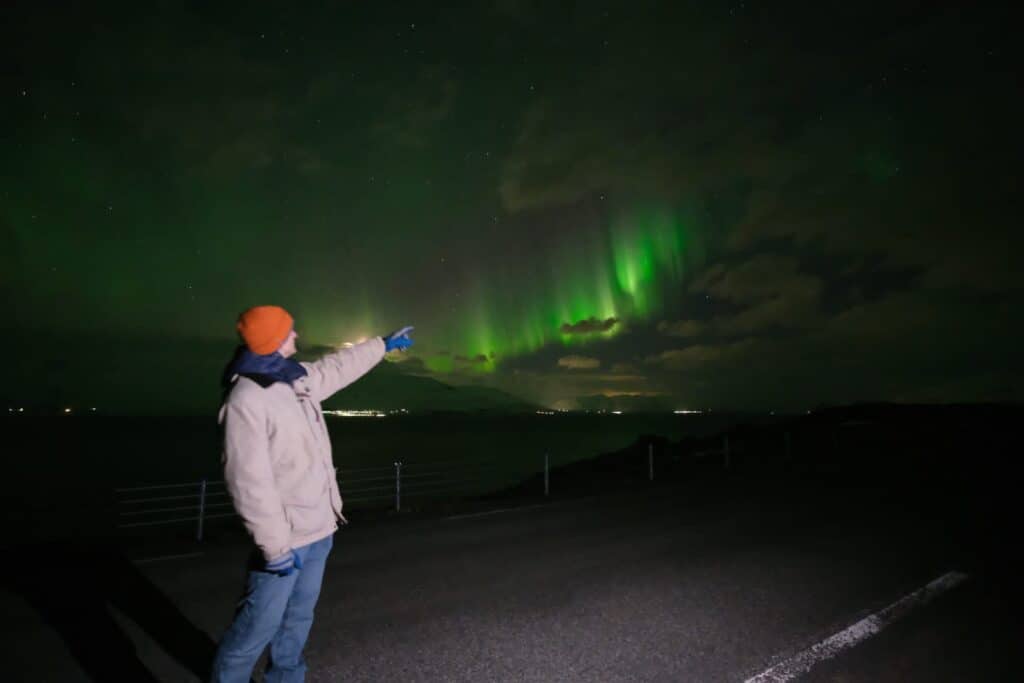
Download an aurora tracking app on your phone
Download My Aurora Forecast on your phone before your trip. It will be your new favorite app.
Plan your trip for a new moon if you can
You want the skies as dark as possible for the northern lights. A full moon can make the lights dimmer or prevent them from being seen completely. If you can, plan to visit Iceland around a new moon.
Get away from town
Similarly, you’ll see the lights most clearly far away from any light pollution. Once you’re about 10-15 miles outside of Akureyri you really shouldn’t have any problem with light pollution.
Stay up late
The best lights often appear early in the morning. If the skies are clear and the aurora forecast is good, you should consider staying up late to search for the lights.
Invest in a good camera for amazing northern lights photos
A good digital camera is needed for the best northern lights photos. While I have some great photos from my phone, you can see the difference below in the photo photo versus the camera photo. There is a full section on northern lights photography in my northern lights tips post, so be sure to check that out to learn how to properly photograph the northern lights.


PRO TIP: Want sweet photos of yourself in front of the northern lights? Have someone shine a flashlight on you during the photo. If you don’t do this you will just be a dark blob in the photo as your camera will focus on the lights in the sky and ignore you.
Your eye won’t see it as clear as your camera will
The northern lights never really look as green in person as they do in photos. This can be a bit of a bummer when you’re out there in the freezing cold, but is totally normal. Even if you can’t see any green, your camera will pick it up because it’s better than your human eyes. But don’t worry, when the lights are strong they appear very colorful to the naked eye and you will love it.
If the clouds are really thick, get some sleep
If the sky is just total overcast, your chances of seeing the lights are about zero. When the weather isn’t cooperating, get some sleep and hope for better weather tomorrow.
What to do When the Sun is Out
Even if you’re visiting Akureyri in the depth of winter, there will still be plenty of daylight. So you’re going to have time to explore some of northern Iceland’s most beautiful destinations. Let’s go through those now, so that you’ll know how to fill your days while on a northern lights trip to Akureyri.
Godafoss
Godafoss is one of the most spectacular waterfalls in all of Iceland. Located about a 30 minute drive east of Akureyri, the waterfall is free to visit and has ample parking.
From the parking lot you’ll walk a few minutes along a paved path to the waterfall. Godafoss is only about 12 meters in height, but stretches about 30 meters in a semicircular shape. The views from the observation deck are simply stunning.
In the winter the rocks around the waterfall will be covered in snow and a few icicles will hang from the upper part of the falls. If you’re lucky, you might even see the waterfall totally frozen.
But this is rare and requires consistent temperatures well below freezing. The winter temperature at Godafoss is usually around freezing, but it can feel much colder due to the intense winds that usually blow around the falls.

Dettifoss
Another spectacular waterfall in northern Iceland is Dettifoss. This waterfall is actually the second most powerful waterfall in Europe in terms of water that flows through it each day. However, unlike Godafoss, Dettifoss is a bit of a challenge to visit in winter due to road closures. Always check the road status before attempting to drive there.
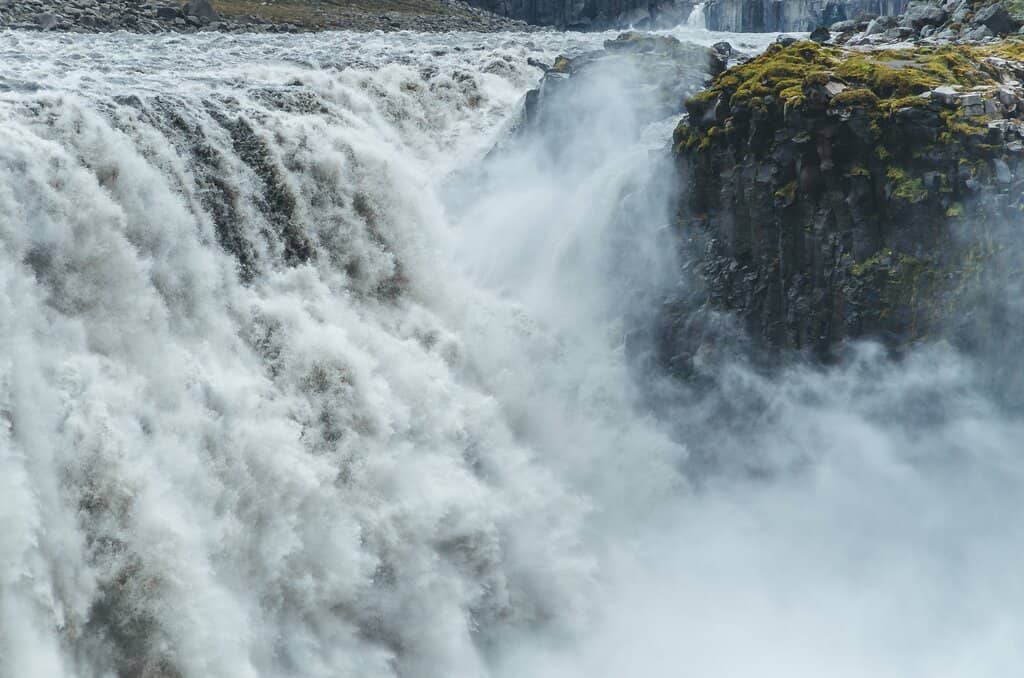
If you’re visiting in fall you should have no problem making it to Dettifoss. Just note that it’s quite a journey from Akureyri, over two hours east and well off the Ring Road (by comparison Godafoss is right on the Ring Road). Due to this it’s far less visited, though, and can be a great place for some solitude with some incredible nature.
Husavik
Husavik is a fishing village on the coast of northern Iceland that is known for whale watching. While most visitors to the country do their whale watching from Reykjavik, Husavik is actually the best spot to catch these beasts in action. It’s actually the oldest settlement in the entire country and features some great seafood restaurants, like Gamli Baukur.
Unfortunately for you, whale watching in Husavik is a summer activity and does not coincide with northern lights viewing. But it’s still a neat little town to check out and grab lunch in.
If you visit in the fall you can hike to the top of Husavik Mountain (not too difficult). If the hills are covered in snow, consider a stop at the Geosea thermal baths. Just note that the baths don’t actually open till 17:00 from Jan 1 to March 31 if you’re visiting Monday – Thursday. They stay open till 22:00 though. So if you’ve ever wanted to see the northern lights from a geothermal pool, this is the place to be!
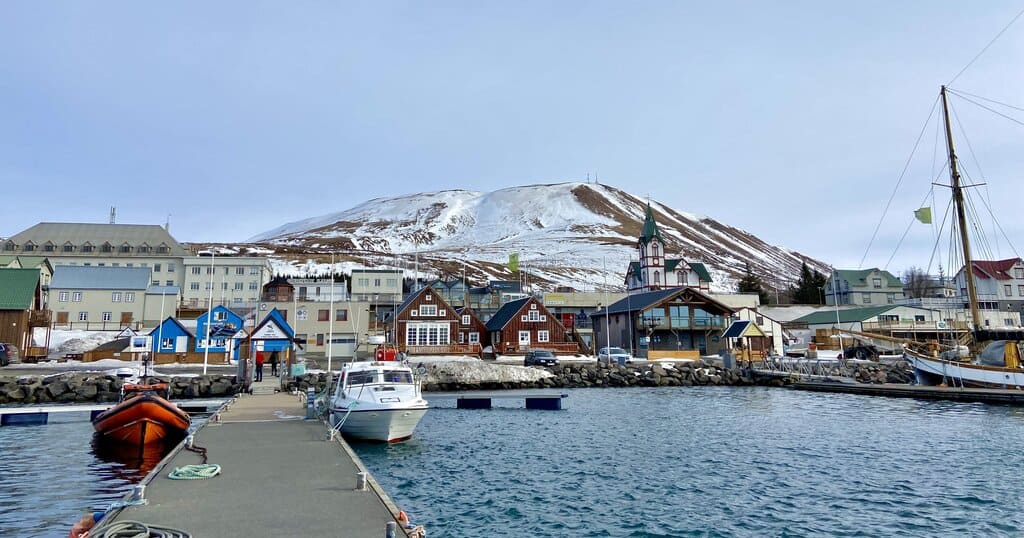
Myvatn
Myvatn is a giant geothermal lake about an hour east of Akureyri. It’s the fourth largest lake in Iceland and is known for its volcanic activity (isn’t all of Iceland known for that though?). The lake is not necessarily for swimming, but there are various viewpoints along the road that encircles the lake.
In addition to the lake itself, there is a geothermal area full of boiling mud pools and smoking ponds. While maybe not as extensive as some other geothermal areas in Iceland like Geysir, it’s still quite impressive.
There’s also an ancient lava field and a giant crater that makes up what is left of the Hverfjall Volcano. It’s really a fascinating area. And if you decide to visit at night, you might get a view similar to what you see in the photo below!
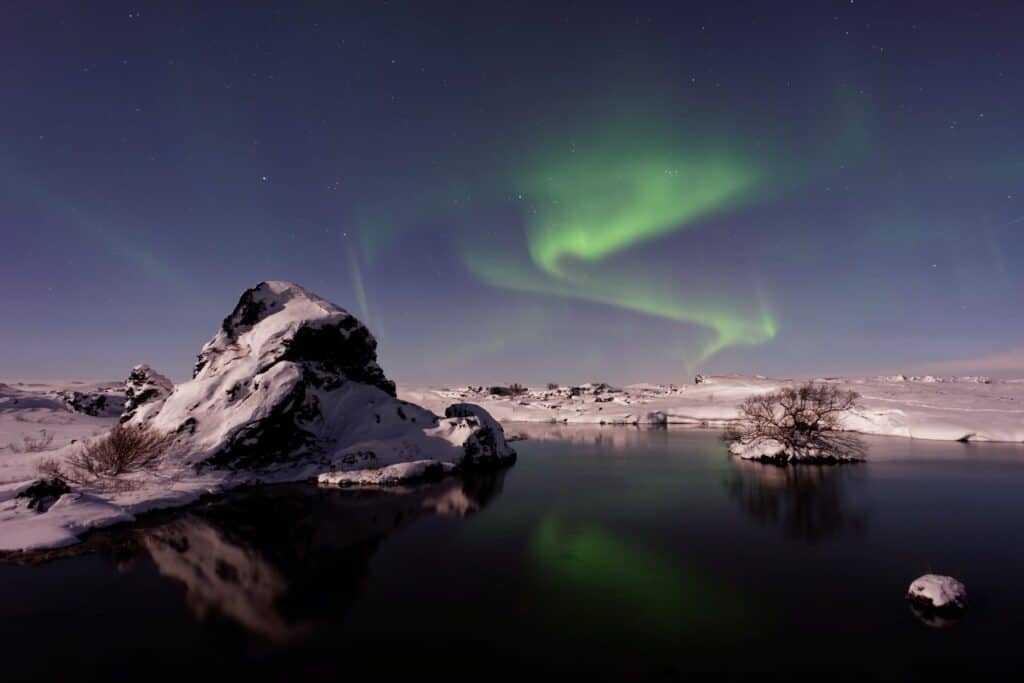
Holar
90 minutes west of Akureyri lies a tiny little village that you’d almost miss if you blinked. But the thing about Holar is its stunning location, isolated away in a deep valley between towering peaks, splendid views every way you look. It was also the unofficial capital of northern Iceland for about 700 years.
Today it’s not much more than the university, a café, a beautiful little church, and some old turf houses (think houses covered in grass). But a stop by Holar certainly won’t disappoint. If you visit in the fall and wish to hike then look no further than the Mt. Gvendarskál hike. Just note that the top of the mountain will likely have snow on it unless you’re there in peak summer.
Dog sledding
One of the most magical winter experiences in arctic regions is dog sledding across the snow. In northern Iceland, your outfitter for this experience is goHusky. They are just outside of the city and offer short dogsledding expeditions for about $210 per person. Dog sledding is amazing and I highly recommend it to anyone. Though I’d argue that dog sledding in Finland is the way to go!
Just drive
Sometimes the best thing to do in northern Iceland is just drive and observe the stunning beauty of the landscape. The Iceland Ring Road between Akureyri and Varmahlid is full of jagged peaks and twisting and turning mountain roads.
Or for a real adventure, set out on a drive around the rugged peninsula northwest of Akureyri. The drive will take you a few hours (in good weather) and you’ll pass a few little fishing villages like Siglufjordur and Dalvik as you gaze in awe at the magical fjords or northern Iceland.
If you do set out on the journey, make sure to stop at the Segull 67 brewery in Siglufjordur. There are a few restaurants in town to stop and have a nice lunch at as well. As you continue along the coast you’ll pass Holar, as well as numerous other small villages, where people still live the simple life surrounded by endless nature.
Frequently Asked Questions
Can you see the northern lights in Akureyri?
Yes, you can see the northern lights in Akureyri, Iceland. In fact it’s one of the best places in the world to see the aurora borealis.
Do northern lights happen every night?
The northern lights are pretty much there every night in polar regions throughout the year. It just takes complete darkness as well as clear skies to see them. Some nights they are more radiant than others, and sometimes the solar winds are just so weak you won’t see them. But if you’re in a polar region and it’s pitch black and the sky is clear, you’re likely to see them if you stay out.
Are the northern lights better in Norway or Iceland?
The northern lights don’t really care about whey they appear, so no one location has better northern lights than another and the magnitude of the solar winds that create the lights changes constantly. It’s all about the weather when it comes to seeing the northern lights. While places like the Lofoten Islands in Norway are above the Arctic Circle, Norwegian weather is notoriously cloudy and rainy. Iceland is definitely a better place to see the northern lights than Norway.
How far is Akureyri from the Arctic Circle?
Akureyri is about 100 km from the Arctic Circle, meaning that at the summer solstice the sun only sets for a few minutes. Conversely, at the winter solstice the sun barely rises. But there are a few hours of twilight every day that lightens up the mid-day hours.
Will I definitely see the northern lights in Iceland?
No, you will surely not “definitely” see the northern lights in Iceland. Seeing the northern lights requires clear skies, which can often be hard to come by in polar regions. People have gone to Iceland for an entire week and had rain every night. That being said, I’ve seen brilliant northern lights 3 of the 4 times I’ve been to Iceland.
Final Word on Seeing the Northern Lights in Akureyri
Chasing the northern lights in Akureyri is an amazing way to spend a winter vacation. Northern Iceland is a bit snowier than the southern half of the island, but overall it gets clearer skies. So it’s the perfect place to hunt for those magical northern lights.
Should you be brave enough to make the drive up from the south you’ll be rewarded with endless views every way you look and you’ll probably even get to see the sky turn green over a fjord. Now what are you waiting for? Book that trip to Iceland already!


1 comment
[…] One of the best places to see the northern lights in Europe is in and outside of Akureyri in norther…. While this part of Iceland regularly receives more snow overall than southern Iceland, the skies are often clearer at night, which is key for northern lights viewing. Akureyri is also almost always along the path of the solar winds and often has high KP forecasts, the other key ingredient for the northern lights. […]